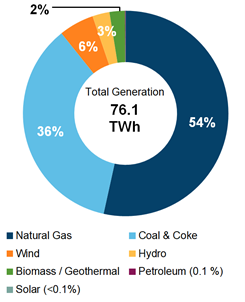
When it comes to climate change, the evidence is irrefutable. Anthropogenic CO2 is causing the Earth to warm, and it is impacting the lives of every citizen. Largely through the consumption of fossil fuels resulting in the release of CO2 into the atmosphere we are experiencing more frequent extreme weather, wildfires, hurricanes, drought, and intense heat waves that impact everyday life. Climate change is a critical problem for our generation, and now is the time to act. Now is the time to make a change and decarbonize our energy systems, and nobody is more well-equipped than our energy industry to lead the way.
Our Future Energy Mix
There is no “silver bullet” or singular solution to the future of our energy mix. In fact, it will take all forms of energy – solar, wind, hydro, nuclear, bioenergy, hydrogen, and conventional fossil-based sources such as oil or natural gas paired with carbon capture and storage (CCS) to achieve a net zero state. We must be able to produce affordable, safe, secure, reliable, and clean energy for everyone, and that means different regions may have other solutions to their energy mix. It is important that we remain agnostic to the different energy sources and utilize what makes sense both from a cost perspective and a practical perspective in different regions of Canada. If we produce clean or low-carbon energy at a cost that people can’t afford, then we are missing the mark.
Electricity Generation
Our approach to the future energy mix also must be practical and play to the strengths of each Province and Territory. When we think about electricity generation, each Province has a different mix of energy sources used for generating power. Provinces such as British Columbia or Manitoba have a clean grid powered mainly by hydro, while Provinces such as Alberta and Saskatchewan rely on cheap and abundant fossil fuels. Solar and Wind are growing as sources but still, only make up a small percentage of electricity production in most provinces. One must also consider the challenge of intermittency, especially in cold climates. When it is -40°C in January, it typically isn’t very windy or sunny, and the reliability of a gas network is heavily relied upon. The strengths and weaknesses of each Province and Territory should be a key point when considering what net zero looks like in Canada, most importantly, the cost to the consumer who is purchasing the energy. With those things in mind, we shouldn’t be against any sources of energy used to generate power, whether it be wind, solar, hydro or natural gas coupled with CCS.

Canada Energy Regulator
(https://www.cer-rec.gc.ca/en/data-analysis/energy-markets/provincial-territorial-energy-profiles/provincial-territorial-energy-profiles-alberta.html)
Home Heating
Another topic of discussion has been how we decarbonize residential/commercial/industrial heating. In British Columbia, the grid is almost entirely powered by hydro. In fact, the grid carbon intensity is extremely low, just 0.0078KgCO2e/kWh(1). When considering home heating, electrification could make sense, given that a significant portion lives near the coast in relatively mild temperatures where heat pumps can work effectively, and the grid is already clean. That said, according to a BC energy provider, in a December 2022 cold snap, there was a peak load of ~10GW on the BC electrical system and a peak load of ~20GW on the natural gas system. The current electrical system has a ~17GW capacity leaving a gap in demand of approximately 13GW that would require new build infrastructure. For context, the Site C dam being constructed in Northeast BC has a capacity of 1GW and has run a cost of $16B over 15 years to build. Using this analysis, one would need to construct another 13 Site C dam equivalent projects (plus grid upgrades) to meet these demand projections leaving the question: is trying to electrify heat practical and the only solution? Or perhaps a complimentary mixture of low-carbon energy sources would be a better solution, especially for home heating? Maybe a mix of both electrification and low-carbon gas? Full electrification can work, but it will be an enormous challenge.
In comparison, another energy provider ran a similar study for the province of Alberta. They found that the infrastructure required to support a transition to hydrogen is 15X more cost-effective than electrification to decarbonize Alberta household heating. Remembering that cost ultimately gets passed down to consumers; it’s really a question of how much homeowners are willing to pay to heat their homes. Do they care where their energy comes from as long as it’s affordable and from a low-carbon source? Again, to solve this issue, we would be best served utilizing a mix of low-carbon solutions along with electrification and not just relying solely on one source.
Mobility
The transportation sector is the second largest greenhouse gas emitter in Canada and accounts for ~23% of total Canadian GHG emissions(2). Given Canada’s vastness, the transportation sector will be challenging to decarbonize; however, like home heating, energy powering the sector can come from a variety of sources.
If you are a hydrogen fuel cell or battery electric advocate, an interesting rule of thumb I’ve heard is: “If it is currently powered by gasoline, then it would be best served to transition to battery electric. If it is powered by diesel, then hydrogen fuel cell may be a better option.” In this view, any light-duty passenger vehicle would ultimately transition to battery electric, while the heavy trucking and rail industry could transition to hydrogen-based energy sources. Again, it would be wise to zoom out and evaluate the mobility transition in a similar view as we did when considering electrifying heat. Different regions with differing climates or strengths may have different solutions than others. It might make sense to electrify heavy hauling in some areas, such as within cities, while long haul trucking in cold winter regions might be better served by hydrogen fuel cells where the cold weather won’t severely impact the vehicles’ range. Another option may be from renewable-based fuels such as renewable diesel, which seems to perform better in winter conditions than traditional biodiesels. Ultimately, the mobility sector should follow a similar approach in that different solutions may work better in differing regions.
Energy Infrastructure
Timelines are short, and 2050 will come fast. To have any hope of achieving our 2030 interim target or being a net zero nation by 2050, new infrastructure will have to be built and built fast. While utilizing existing infrastructure to support decarbonization is the preferred option, it may not always be technically feasible. When it comes to energy infrastructure, we would encourage a shift away from the current singular asset view and instead consider a more integrated approach. Perhaps we could push towards developing national energy corridors, which would include everything from oil, gas, H2, or CO2 pipelines as well as transmission lines, all of which would aim to carry decarbonized energy to Canadians. We must also consider the joint development of projects from the production of energy, through to end users. It is time to move away from focusing on “oil and gas” production projects or “wind and solar farms” projects as singular pieces of infrastructure. In a decarbonized future, these projects will be closely linked and vital in delivering decarbonized energy to Canadians, whether through electrons and transmission lines or hydrogen through pipelines.
These are just a few viewpoints and examples of how there are different solutions to addressing the greatest challenge of our time – reducing emissions while ensuring the livelihood of all people. It requires all forms of energy working together. We reject the notion that come 2050, the energy future will be dominated by oil and gas; at the same time, we also reject the notion that the energy future will be dominated by renewable energy as well. We need energy of all forms to work together towards a common, low-carbon and sustainable future.
Derek McLean
Derek McLean is a Northern Alberta Chair at Young Energy Infrastructure Professionals
References:
(1) National Inventory Report 1990–2020: Greenhouse Gas Sources and Sinks in Canada (2022), Government of Canada.